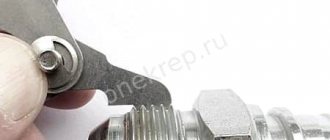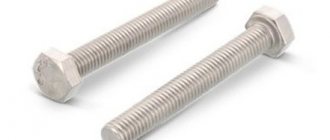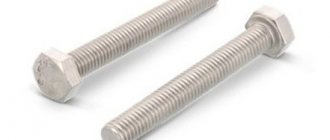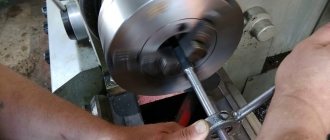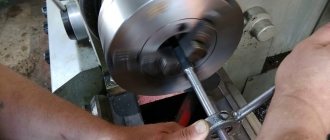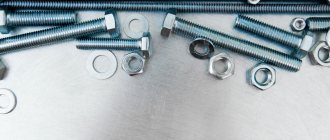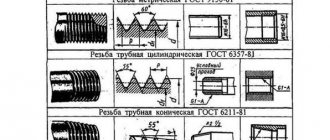Symbol of fasteners - bolts, nuts, screws, studs, washers
How to understand the designation of fasteners.
When designating fasteners (bolts, nuts, screws, studs, washers) in drawings, specifications and technical documentation, in order to avoid discrepancies, approved complete symbols of the same form for all cases must always be used. But, due to negligence, laziness, haste, as well as the technical illiteracy of many engineering and technical workers, various types of symbols appeared and found widespread use:
- full designations: Bolt V3M12x1.25-6gx50.58.S.019 GOST ..., Nut 2M6LH-6N.8.016 OST ..., Washer A30.01.08kp.019 GOST ... etc.
- abbreviated designations - formed from full ones by abbreviating parameters that are not essential for this fastening application: Screw M8-8gx60.029 GOST ..., Nut M16-6N.032 GOST ..., Washer 10.019 OST ... etc.
- simplified designations - only the main parameters and requirements are indicated: Washer 14, Nut M16 GOST ..., Bolt 12x25 oc GOST ..., Screw 6x45 chemical ox. GOST...
The indication of GOST, OST or TU in the fastener designation is mandatory, since the standard number determines the design and geometric shape of the fastener, manufacturing accuracy, and in some cases also the steel grade, fastener strength and other parameters. All types of designations are derived from the full designation, the correct spelling of which is dictated by standards: for fasteners with threads up to 48 mm - GOST 1759.0-87, for fasteners with threads over 48 mm - GOST 18126-94. Someone will object that “abbreviated” and “simplified” notations absolutely exist and are used precisely because the parameters not specified in them are unimportant and are not required in this particular case. It can only be noted that there are no approved regulatory documents on this matter.
Full symbol.
The full designation of bolts, screws, studs and nuts is standardized by GOST 1759.0-87 “Bolts, screws, studs and nuts. Technical specifications"
In the post-Soviet space, in accordance with GOST 1759.0-87 and GOST 18126-94, the following symbol scheme has been adopted for bolts, screws and studs and nuts made of carbon steels and non-ferrous alloys:
For washers, a slightly different symbol scheme is used according to GOST 18123-82 “Washers. General technical conditions":
The above diagrams have a general appearance, with all possible elements. Depending on the type of fastener, the designation may contain more or fewer elements. It should also be noted that some types of bolts, studs, nuts and washers have their own specific symbols, standardized by a specific standard (for example: foundation bolts GOST 24379.1-80, studs for flange connections GOST 9066-75, etc.)
Examples of designations for various fasteners.
Let's look at the designations of various fasteners using examples with explanations:
Bolt 3M12x1.25LH-6gx50.58.C.019 GOST 7798-70
In this example of a bolt designation, the following elements are used:
Bolt - name of the fastener;
B - bolt accuracy class (there are three accepted accuracy classes: A, B and C; the most accurate is class A); in this example, accuracy class B is not indicated, since it is dictated by the GOST 7798-70 standard indicated below - according to this standard, bolts cannot be of an accuracy class other than B;
3 - bolt design (depending on the standard, there can be from 1 to 4 designs; if the design is not indicated in the bolt designation, this means that design 1 is used - the number “1” is not indicated);
M - type of thread (depending on the standard, the thread may be: M - metric; K - conical; Tr - trapezoidal);
12 - nominal bolt thread diameter in millimeters, mm;
1.25 - bolt thread pitch (if the thread pitch is large (main), then it is not indicated; only small and especially small thread pitch is indicated in millimeters, mm - in this example, a thread pitch of 1.25 mm is small for an M12 thread, t .because the large main pitch for M12 thread is 1.75 mm);
LH - designation of thread cutting direction - left thread (if the thread has a right cutting direction (main), then the cutting direction is not indicated);
6g - thread tolerance field - determines the accuracy class of thread manufacturing (there is a fine, medium, coarse class - indicated by numbers from 4 to 8 with Latin letters; fine class - 4, coarse class - 8);
50 - bolt length in millimeters, mm;
58 - bolt strength class (do not put a dot between the numbers in the designation); The approved strength series for bolts made of carbon steel contains 11 strength classes: designated 36; 46; 48; 56; 58; 66; 68; 88; 98; 109; 129);
C - indication of the use of calm (C) or free-flowing (A) steel - for bolts of strength class up to 6.8; for bolts of strength classes 8.8 and higher, as well as for bolts made of alloy and special steels and alloys, the grade of steel or alloy used is indicated here;
01 - digital designation of the type of coating; designations of coating numbers from 01 to 13 are used;
9 – coating thickness in microns, microns;
GOST 7798-70 - type and number of the standard for the design and geometric parameters of the bolt.
Screw VM16-6gx45.45N.40X.05 GOST 1482-84
In this example of a set screw designation, the following elements are used:
Screw - name of the fastener;
B - screw accuracy class (there are three accepted accuracy classes: A, B and C; the most accurate is class A);
1 - design of the screw (depending on the standard, there can be from 1 to 4 designs; if the design is not indicated in the designation of the screw, this means that design 1 is used - the number “1” is not indicated);
M - type of thread (depending on the standard, the thread may be: M - metric; K - conical; Tr - trapezoidal);
16 - nominal screw thread diameter in millimeters, mm;
2 - screw thread pitch (if the thread pitch is large (main), as in this example, then it is not indicated; only small and especially small thread pitch is indicated in millimeters, mm;
6g - thread tolerance field - determines the accuracy class of thread manufacturing (there is a fine, medium, coarse class - indicated by numbers from 4 to 8 with Latin letters; fine class - 4, coarse class - 8);
45 - screw length in millimeters, mm;
45N - strength class of the set screw (the approved strength series for set screws contains 4 strength classes: designated 14N; 22N; 33N; 45N);
40Х - indication of the screw steel grade;
05 - digital designation of the type of coating; designations of coating numbers from 01 to 13 are used;
GOST 1482-84 - type and number of the standard for the design and geometric parameters of the screw.
Nut 2М10х1LH-6Н.32.079 GOST 5927-70
In this example of a nut designation, the following elements are used:
Nut - name of the fastener;
A - nut accuracy class (there are three accepted accuracy classes: A, B and C; the most accurate is class A); in this example, accuracy class A is not indicated, since it is dictated by the GOST 5927-70 standard indicated below - according to this standard, nuts cannot have an accuracy class other than A;
2 - version of the nut (depending on the standard, there can be from 1 to 3 versions; if the version is not indicated in the designation of the nut, this means that version 1 is used - the number “1” is not indicated);
M - type of thread (depending on the standard, the thread may be: M - metric; K - conical; Tr - trapezoidal);
10 - nominal diameter of the nut thread in millimeters, mm;
1 - thread pitch of the nut (if the thread pitch is large (main), then it is not indicated; only small and especially small thread pitch is indicated in millimeters, mm - in this example, a thread pitch of 1 mm is especially small for M10 threads, because the large main pitch for M10 thread is 1.5 mm);
LH - designation of thread cutting direction - left thread (if the thread has a right cutting direction (main), then the cutting direction is not indicated);
6H - thread tolerance field - determines the accuracy class of thread manufacturing (there is a fine, medium, coarse class - indicated by numbers from 4 to 8 with Latin letters; fine class - 4, coarse class - 8);
32 - indication of the nut material group - in this case, brass L63 - group 32;
07 - digital designation of the type of coating; designations of coating numbers from 01 to 13 are used;
9 – coating thickness in microns, microns;
GOST 5927-70 - type and number of the standard for the design and geometric parameters of the nut.
Hairpin 2M24x1.5LH-6gx220.109.45.029 GOST 22032-76
In this example of a stud designation, the following elements are used:
Hairpin - name of the fastener;
B - pin accuracy class (there are three accepted accuracy classes: A, B and C; the most accurate is class A); in this example, accuracy class B is not indicated, since it is dictated by the GOST 22032-76 standard indicated below - according to this standard, studs cannot have an accuracy class other than B;
2 - stud design (depending on the standard, there can be from 1 to 6 designs; if the design is not indicated in the stud designation, this means that design 1 is used - the number “1” is not indicated);
M - type of thread (depending on the standard, the thread may be: M - metric; K - conical; Tr - trapezoidal);
24 - nominal diameter of the stud thread in millimeters, mm;
1.5 - thread pitch of the stud (if the thread pitch is large (main), then it is not indicated; only small and especially small thread pitch is indicated in millimeters, mm - in this example, a thread pitch of 1.5 mm is small for an M24 thread, t .because the large main pitch for M24 thread is 3 mm);
LH - designation of thread cutting direction - left thread (if the thread has a right cutting direction (main), then the cutting direction is not indicated);
6g - thread tolerance field - determines the accuracy class of thread manufacturing (there is a fine, medium, coarse class - indicated by numbers from 4 to 8 with Latin letters; fine class - 4, coarse class - 8);
220 - length of the stud in millimeters, mm;
109 - stud strength class (do not put a dot between the numbers in the designation); The approved strength series for studs made of carbon steel contains 11 strength classes: designated 36; 46; 48; 56; 58; 66; 68; 88; 98; 109; 129);
45 - indication of the steel grade of the stud;
02 - digital designation of the type of coating; designations of coating numbers from 01 to 13 are used;
9 – coating thickness in microns, microns;
GOST 22032-76 - type and number of the standard for the design and geometric parameters of the stud.
Washer 2.20x0.5.01.08kp.099 GOST 13463-77
In this example of the designation of a lock washer with a tab, the following elements are used:
Washer - name of the fastener;
A - accuracy class of the washer (there are three accepted accuracy classes: A, B and C; the most accurate is class A); in this example, accuracy class A is not indicated, since it is dictated by the GOST 13463-77 standard indicated below - according to this standard, washers cannot have an accuracy class other than A. If the standard for washers provides for several possible accuracy classes - then the accuracy class is indicated in designation first;
2 - design of the washer (depending on the standard, there can be from 1 to 3 designs; if the design is not indicated in the designation of the washer, this means that design 1 is used - the number “1” is not indicated);
20 is the nominal diameter of the thread of the mating threaded part for which the washer is intended, in millimeters, mm. Thus, the designation of the washer does not indicate the actual diameter of the internal hole of the washer, but the diameter of the corresponding threaded fastener (the diameter of the internal hole of the washer, as a rule, has a slightly larger value);
0.5 - thickness of the washer (if the thickness of the washer corresponds to the specified GOST standard, then it is not indicated; only the special, non-compliant with the GOST standard, thickness in millimeters, mm - in this example, a thickness of 0.5 mm is non-standard for a washer 20, t .k. according to the GOST 13463-77 table, the standard thickness for washer 20 is 1 mm);
01 – washer material group. For washers, possible standard materials are divided into groups:
If the material is non-standard, then the group is not indicated - only the grade of the material is indicated;
08кп - indication of the grade of washer material;
09 - digital designation of the type of coating; designations of coating numbers from 01 to 13 are used;
9 – coating thickness in microns, microns;
GOST 13463-77 - type and number of the standard for the design and geometric parameters of the washer.
APPENDIX 3 (mandatory)
Table 9
Proof load for nuts with height m ≥ 0.8d and coarse thread pitch
| Nominal thread diameter d, mm | Thread pitch P, mm | Cross-sectional area of the mandrelAs, mm² | Test load, H, for group symbols | ||||||||
| 22 | 23 | 24; 25 | 26 | 31 | 32; 33 | 34 | 35 | ||||
| 1,6 | 0,35 | 1,27 | 650 | 750 | 880 | 1120 | 1370 | 330 | 390 | 620 | 470 |
| 2 | 0,4 | 2,07 | 1060 | 1220 | 1430 | 1820 | 2240 | 540 | 640 | 1010 | 770 |
| 2,5 | 0,45 | 3,39 | 1730 | 2000 | 2340 | 2980 | 3660 | 880 | 1050 | 1660 | 1250 |
| 3 | 0,5 | 5,03 | 2570 | 2970 | 3470 | 4430 | 5430 | 1310 | 1560 | 2460 | 1860 |
| 3,5 | 0,6 | 6,78 | 3450 | 3990 | 4670 | 5960 | 7310 | 1760 | 2100 | 3320 | 2500 |
| 4 | 0,7 | 8,78 | 4470 | 5170 | 6050 | 7720 | 9470 | 2280 | 2720 | 4300 | 3240 |
| 5 | 0,8 | 14,2 | 7240 | 8380 | 9800 | 12500 | 15300 | 3690 | 4400 | 6960 | 5250 |
| 6 | 1 | 20,1 | 10300 | 11900 | 13900 | 17700 | 21700 | 5230 | 6230 | 9850 | 7440 |
| 7 | 1 | 28,9 | 14700 | 17000 | 19900 | 25300 | 31100 | 7490 | 8930 | 14100 | 10700 |
| 8 | 1,25 | 36,6 | 18700 | 21600 | 25300 | 32200 | 39500 | 9520 | 11300 | 17900 | 13500 |
| 10 | 1,5 | 58,0 | 29600 | 34200 | 40000 | 51000 | 62600 | 15100 | 18000 | 28400 | 21500 |
| 12 | 1,75 | 84,3 | 49200 | 49700 | 58100 | 74100 | 90900 | 21900 | 26100 | 41300 | 31200 |
| 14 | 2 | 115 | 587000 | 67900 | 79400 | 101000 | 124000 | 29900 | 35700 | 56400 | 42600 |
| 16 | 2 | 157 | 80100 | 92600 | 108000 | 138000 | 170000 | 40800 | 48700 | 76900 | 58100 |
| 18 | 2,5 | 192 | 97900 | 113000 | 132000 | 169000 | 207000 | 49900 | 59500 | 94100 | 71000 |
| 20 | 2,5 | 245 | 125000 | 145000 | 169000 | 216000 | 265000 | 63700 | 76000 | 120000 | 90700 |
| 22 | 2,5 | 303 | 155000 | 179000 | 209000 | 267000 | 327000 | 78800 | 93900 | 148000 | 112000 |
| 24 | 3 | 353 | 180000 | 208000 | 243000 | 310000 | 380000 | 91500 | 109000 | 172000 | 130000 |
| 27 | 3 | 459 | 234000 | 271000 | 317000 | 404000 | 496000 | 119000 | 142000 | 225000 | 170000 |
| 30 | 3,5 | 561 | 286000 | 330000 | 386000 | 493000 | 605000 | 146000 | 174000 | 274000 | 207000 |
| 33 | 3,5 | 694 | 353000 | 409000 | 478000 | 610000 | 748000 | 180000 | 215000 | 340000 | 256000 |
| 36 | 4 | 817 | 416000 | 480000 | 563000 | 718000 | 881000 | 212000 | 253000 | 400000 | 302000 |
| 39 | 4 | 976 | 497000 | 575000 | 673000 | 858000 | 1053000 | 254000 | 302000 | 478000 | 361000 |
| 42 | 4,5 | 1120 | 571000 | 661000 | 773000 | 986000 | 1210000 | 291000 | 347000 | 549000 | 414000 |
| 45 | 4,5 | 1305 | 666000 | 770000 | 900000 | 1148000 | 1409000 | 339000 | 405000 | 640000 | 483000 |
| 48 | 5 | 1472 | 751000 | 868000 | 1016000 | 1296000 | 1590000 | 383000 | 456000 | 721000 | 545000 |
Table 10
Test loads for nuts height m ≥ 0.8d with fine thread pitch
| Nominal thread diameter d, mm | Thread pitch P, mm | Cross-sectional area of the mandrelAs, mm² | Test load, H, for group symbols | ||||||||
| 21 | 22 | 23 | 24; 25 | 26 | 31 | 32; 33 | 34 | 35 | |||
| 8 | 1 | 39,2 | 19900 | 23100 | 27000 | 34400 | 42200 | 10200 | 12100 | 19200 | 14500 |
| 10 | 1 | 64,5 | 32900 | 38100 | 44500 | 56800 | 69700 | 16800 | 20000 | 31600 | 23900 |
| 10 | 1,25 | 61,2 | 31200 | 36100 | 42200 | 53900 | 66100 | 15900 | 19000 | 30000 | 22600 |
| 12 | 1,25 | 92,1 | 46900 | 54300 | 63500 | 81000 | 99400 | 23900 | 28500 | 45100 | 34000 |
| 12 | 1,5 | 88,1 | 44900 | 52000 | 60800 | 77500 | 95100 | 22900 | 27300 | 43200 | 32600 |
| 14 | 1,5 | 125 | 63200 | 73200 | 85600 | 109000 | 134000 | 32200 | 38400 | 60800 | 45900 |
| 16 | 1,5 | 167 | 85200 | 98500 | 115000 | 147000 | 180000 | 43400 | 51800 | 81800 | 61800 |
| 18 | 1,5 | 216 | 110000 | 127000 | 149000 | 190000 | 233000 | 56200 | 67000 | 106000 | 79900 |
| 18 | 2 | 204 | 104000 | 120000 | 141000 | 180000 | 220000 | 53000 | 63200 | 100000 | 75500 |
| 20 | 1,5 | 272 | 138000 | 100000 | 187000 | 238000 | 293000 | 70500 | 84000 | 133000 | 100000 |
| 20 | 2 | 258 | 132000 | 152000 | 178000 | 227000 | 279000 | 67100 | 80000 | 126000 | 95500 |
| 22 | 1,5 | 333 | 170000 | 196000 | 230000 | 293000 | 360000 | 86600 | 103000 | 163000 | 123000 |
| 22 | 2 | 318 | 162000 | 188000 | 219000 | 280000 | 343000 | 82700 | 98600 | 156000 | 118000 |
| 24 | 1,5 | 401 | 205000 | 237000 | 277000 | 353000 | 433000 | 104000 | 124000 | 196000 | 148000 |
| 24 | 2 | 384 | 196000 | 327000 | 265000 | 338000 | 415000 | 99800 | 119000 | 188000 | 142000 |
| 27 | 2 | 496 | 252000 | 292000 | 342000 | 436000 | 535000 | 129000 | 153000 | 243000 | 183000 |
| 30 | 2 | 621 | 317000 | 366000 | 428000 | 546000 | 671000 | 161000 | 193000 | 304000 | 230000 |
| 33 | 2 | 761 | 388000 | 448000 | 524000 | 669000 | 821000 | 198000 | 236000 | 372000 | 281000 |
| 36 | 3 | 865 | 441000 | 510000 | 596000 | 760000 | 933000 | 225000 | 268000 | 423000 | 320000 |
| 39 | 3 | 1030 | 524000 | 607000 | 709000 | 905000 | 1105000 | 266000 | 317000 | 501000 | 379000 |
| 42 | 3 | 1205 | 615000 | 711000 | 831000 | 1060000 | 1301000 | 313000 | 374000 | 590000 | 446000 |
| 45 | 3 | 1397 | 712000 | 824000 | 964000 | 1229000 | 1509000 | 363000 | 433000 | 685000 | 517000 |
| 48 | 3 | 1603 | 818000 | 946000 | 1122000 | 1411000 | 1731000 | 417000 | 497000 | 785000 | 593000 |
16.2. Nuts
Nuts are screwed onto the threaded end of the bolt, with the parts being connected being clamped between the nut and the head of the bolt.
Nut symbol
:
Nut M 24 -6N. 6 GOST 5915-70 – hex nut version 1 according to GOST 5915-70 with a tolerance range of 6H, strength class 6, without coating. Most often, hex nuts are used, the design and dimensions of which are determined by GOST. They are divided into regular (Figure 16.2), slotted (Figure 16.3) and crown (Figure 16.4).
Conventional nuts are available in three designs and three accuracy classes (A, B, C), normal height, low, high, very high (Figure 16.5), with a normal or reduced turnkey size.
Figure 16.2
Figure 16.3 Figure 16.4
Figure 16.5
Operation of High Strength Bolts (Spheres, Areas and Examples)
The use of high-strength bolts is often found in such areas as construction, road equipment manufacturing, instrument and mechanical engineering, as well as other production-related areas. The high demand for them is due to the fact that such hardware has practically no restrictions on use and is used in toxic aggressive environments and at low temperatures (down to −60C).
High-strength fasteners can withstand both constant and variable loads, with a moving center of gravity, and even strong vibrations. Therefore, with the help of these hardware, buildings are built, industrial equipment, heavy equipment (including military) and special purpose vehicles (cranes, loaders, etc.) are manufactured.
Rules for installing high-strength bolts
Before starting work, a preliminary analysis of the technical operating conditions of the future structure is always carried out. The selection of the required hardware will be influenced by the following factors:
- Characteristics of additional accessories.
- Twist factor.
- Correspondence of the technical and mechanical properties of the hardware to the environment in which it will work.
- Resistance to various external influences.
- Properties of the steel from which it is made.
- Thread pitch and type.
The conditions for the correct choice are also influenced by the size, shape of the bolt head, the presence of heat treatment and protective coating. Always start from the purposes for which you need hardware. The further procedure is as follows:
- The holes in the connected elements are aligned and the elements are rigidly secured using assembly plugs. Usually a tenth of the holes are secured with plugs - this is quite enough for reliable fixation.
- High-strength bolts are inserted into the holes free of plugs and tensioned in accordance with the rules and with the force specified in the technical documents.
- Then remove the assembly plugs, install the remaining bolts and tighten all the parts to the design strength. After this, the working surface can be primed.
Use a calibration wrench that allows you to control and adjust the tension of the bolts.
Manufacturing technology
In the modern world, several technologies are used to make nuts. Some of them are used to produce large quantities of fasteners with a minimum amount of scrap and optimal consumption of materials. The process occurs virtually without human intervention, automatically. The main methods for producing nuts in large volumes are cold stamping technology and hot forging.
Cold stamping
It is a fairly progressive technology that allows the mass production of fasteners with small losses of no more than 7% of the total number of products. Special automated machines allow you to produce up to 400 products within a minute.
Stages of manufacturing fasteners using cold technology.
- Rods are prepared from the required type of steel. Before processing, they are cleaned of rust or foreign deposits. Phosphates and a special lubricant are then applied to them.
- Slicing. Metal blanks are placed in a special mechanism and cut into pieces.
- The nut blanks are cut off using a movable cutting mechanism.
- Stamping. After all the previous manipulations, the blanks are sent to a hydraulic stamping press, where they are shaped and a hole is punched.
- The final stage. Cutting threads inside parts. This operation is carried out on a special nut-threading machine.
After completing the work, some nuts from the batch must be checked for compliance with the parameters specified in advance. These are the dimensions, thread and maximum load that the product can withstand. To produce hardware using this technology, a certain steel intended for cold stamping is used.
Hot forging
The hot technology for producing nuts is also very common. The raw materials for the production of hardware using this method are also metal rods, cut into pieces of the required length.
The main stages of production are as follows.
- Heat. Cleaned and prepared rods are heated to a temperature of 1200 degrees Celsius so that they become plastic.
- Stamping. A special hydraulic press forms hexagonal blanks and punches a hole inside them.
- Thread cutting. The products are cooled and threads are applied inside the holes. For this, rotating rods resembling taps are used. To facilitate the process and prevent rapid wear during cutting, machine oil is supplied to the parts.
- Hardening. If products require increased strength, they are hardened. To do this, they are heated again to a temperature of 870 degrees Celsius, cooled at high speed and immersed in oil for about five minutes. These actions harden the steel, but it becomes brittle. To get rid of fragility while maintaining strength, hardware is kept in an oven at high temperature (800-870 degrees) for about an hour.
After all processes are completed, the nuts are checked on a special stand to ensure they meet the strength requirements. After inspection, if the hardware passes it, they are packaged and sent to the warehouse. The production facilities still have outdated equipment in need of repair and maintenance work. To produce fasteners for such equipment, lathes and milling machines are used. However, such work is characterized by very low productivity and huge consumption of materials. But they are needed in any case, and therefore for small batches of fasteners this technology still remains relevant.
See the following video for the process of making nuts and other hardware.
